In Autumn (Fall) 2025/ Spring 2026, CFD Direct is running its OpenFOAM Training courses — Essential CFD, Applied CFD, Productive CFD and Programming CFD — fully updated with the latest features of the new version 13 release of OpenFOAM. Our Productive CFD and Programming CFD courses are provided in-person in Cologne, Germany and Chicago and Houston, USA, while Essential CFD and Applied CFD are virtual instructor-led. All courses are available as on-site training. Training has become increasingly important as the quality of Internet Search steadily declines. Our team has the experience to fill the knowledge gap between what users need and what Internet Search provides.
Subscribe to CFD Direct News
Subscribe to our monthly newsletter to hear the latest on OpenFOAM developments, new releases, documentation, videos, tips, cloud computing, training courses and more. The newsletters are short and informative and low frequency. *Subscribers must provide consent to the processing of their personal data in accordance with our Privacy Policy and the EU GDPR.
CFDDFC® v13 Released
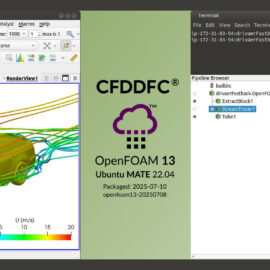
CFD Direct announces the release of version 13 of CFD Direct From the Cloud™ (CFDDFC®), available on Amazon Web Services (AWS) Marketplace as the standard CFDDFC product, Web CFDDFC and CFDDFC (Arm). CFDDFC v13 includes OpenFOAM v13, ParaView v5.10, OpenMPI v4.1.7 and FreeCAD v0.21, running on Ubuntu 22.04 LTS. Standard CFDDFC can be accessed using the X2Go remote desktop client whereas Web CFDDFC and CFDDFC (Arm) are accessible using a remote desktop in a browser. A single instance can run CFDDFC and Web CFDDFC on up to 96 cores and CFDDFC (Arm) on up to 192. Instances can be clustered to run with 1000 cores or more.
OpenFOAM v13 Training

In Autumn 2025, CFD Direct is running its OpenFOAM Training courses — Essential CFD, Applied CFD, Productive CFD and Programming CFD — fully updated with the latest features of the new version 13 release of OpenFOAM. The training uses new features in OpenFOAM v13 for more productive and effective CFD, including: foamFind, unit conversion, coded and packaged function object, meshing multiple regions and coupling with boundary conditions. Productive CFD is available 15-18 Sep and 20-23 Oct. Essential and Applied CFD courses are available: 22-26 Sep, 6-10 Oct. Programming CFD is available 20-22 Oct, 3-5 Nov.
Dynamic Zones in OpenFOAM
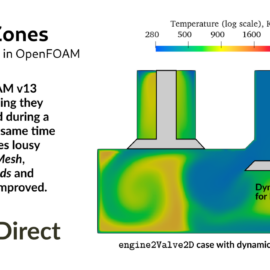
In June 2025, Henry Weller at CFD Direct completed a rewrite of mesh zones and associated tools, released in OpenFOAM v13 by The OpenFOAM Foundation. The aim behind the rewrite of mesh zones was to make them dynamic, so they would work effectively for complex CFD problems, especially involving moving meshes. The new design includes createZones which provides a simpler, more powerful replacement for the lousy topoSet. Other utilities which have been rewritten, and are far better to use as a result, include setFields, refineMesh (making the separate refineHexMesh redundant), createPatch and subsetMesh.
The Best OpenFOAM is v13
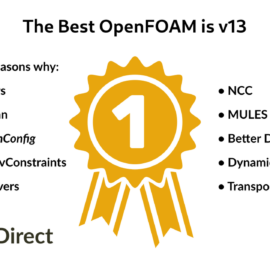
OpenFOAM v13, produced by CFD Direct and released via The OpenFOAM Foundation, is the best version of OpenFOAM today. By “ best” we mean the software which best meets the critical needs of users — availability, usability, robustness and extensibility. It is redesign work that has greatest impact on these criteria and which CFD Direct has provided time and again, delivering new, improved software components. Examples include modular solvers, NCC, field-Lagrangian, bounded MULES, dynamic zones, improved dynamic meshes, snappyHexMeshConfig, fvModels and fvConstraints, liquid film modular solver and dedicated transport libraries.
CFD Direct: 10 years (2015-2025)
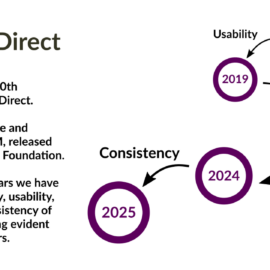
In March 2025, CFD Direct celebrated its 10th anniversary. CFD Direct was founded by Henry Weller (creator of FOAM), Chris Greenshields (OpenFOAM co-founded) and Jenya Collings in March 2015. It maintains, develops and manages OpenFOAM, released via The OpenFOAM Foundation. Over the past 10 years it has improved the quality, usability, robustness and consistency of OpenFOAM, bringing evident benefit to all its users. CFD Direct also provides services to users of OpenFOAM, including development, CFD support and consultancy, OpenFOAM training and cloud computing (CFDDFC®).
MULES in OpenFOAM in 2025
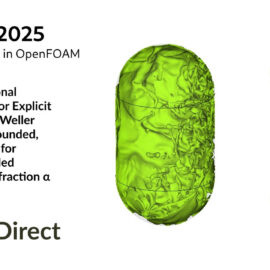
In February 2025, there were significant improvements to MULES in the development line of OpenFOAM which make it extremely robust, easier to use, and quicker to run. The changes include: improvements to the iterative MULES algorithm to guarantee boundedness of solutions; a new control structure for the MULES parameters; an optional tolerance for limiter convergence for semi-implicit MULES; better control for sub-cycling the α-equation based on setting a function of the α-Courant number.
Field-Based Lagrangian
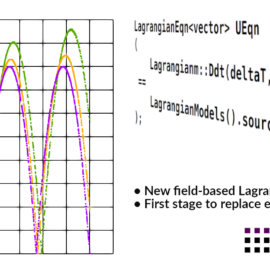
This article is a user guide to the new field-based Lagrangian functionality in OpenFOAM. This is a new implementation of Lagrangian functionality where data is stored as fields rather than in the objects representing particles or parcels (particle-based Lagrangian). It will ultimately replace the original particle-based Lagrangian and is 65% complete and available in OpenFOAM-dev. Field-based Lagrangian has the advantages of: better extensibility, since fields can be simply added; greater efficiency of fewer function calls using field algebra; greater code reuse due to consistency with the rest of OpenFOAM.
Productive CFD: OpenFOAM Training Course
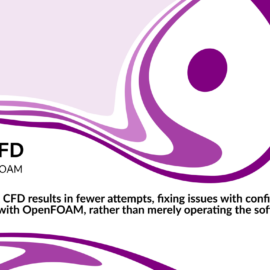
CFD Direct is delighted to announce Productive CFD, their new CFD Training course with OpenFOAM. The course was created by Chris Greenshields and Aidan Wimshurst drawing on the experience of Chris’s 16 years of OpenFOAM Training and Aidan’s Fluid Mechanics 101 channel. The course focuses on performing high quality CFD with OpenFOAM, rather than merely operating the CFD software. It explains how to get better, relevant results in fewer attempts, identifying and fixing issues quickly and with confidence. The course is split into 2 parts, each of 2 days duration, and is delivered in person with 2025 dates of 15-18 September 2025, Cologne, Germany and 20-23 October 2025, Chicago, USA.
OpenFOAM v12 Training 2025

In Winter/Spring 2025, CFD Direct is running its OpenFOAM Training courses — Productive CFD, Essential CFD, Applied CFD and Programming CFD — fully updated with the latest features of the new version 12 release of OpenFOAM. The training uses new features in OpenFOAM v12 for more productive and effective CFD, including: foamFind, unit conversion, coded and packaged function objects, meshing multiple regions and coupling with boundary conditions. Productive of CFD is available 17-20 Mar. Essential and Applied CFD courses are available: 10-14 Feb, 3-7 Mar. Programming CFD is available 24-26 Feb, 24-26 Mar.
CFDDFC® v12 Released
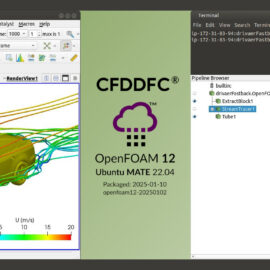
CFD Direct announces the release of version 12 of CFD Direct From the Cloud™ (CFDDFC®), available on Amazon Web Services (AWS) Marketplace as the standard CFDDFC product, Web CFDDFC and CFDDFC (Arm). CFDDFC v12 includes OpenFOAM v12, ParaView v5.10, OpenMPI v4.1.7 and FreeCAD v0.21, running on Ubuntu 22.04 LTS. Standard CFDDFC can be accessed using the X2Go remote desktop client whereas Web CFDDFC and CFDDFC (Arm) are accessible using a remote desktop in a browser. A single instance can run CFDDFC and Web CFDDFC on up to 96 cores and CFDDFC (Arm) on up to 192. Instances can be clustered to run with 1000 cores or more.
Learn Effective CFD

OpenFOAM provides leading CFD software to thousands of people within academia and industry for free. However, CFD is inherently complex and competency in CFD requires more than simply “learning the software package”. Our 3 OpenFOAM Training courses build CFD competency through a process of solution design with course prices equivalent to 1-2 weeks of payroll cost of a CFD engineer or 2% of a single core, commercial CFD licence. Our schedule during Covid-19 travel restrictions includes scheduled live virtual training courses at times to fit with Europe and Americas time zones.
Get the Best OpenFOAM Training
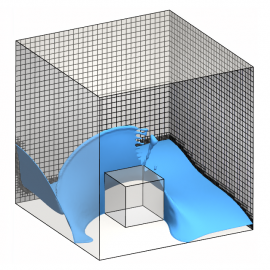
Anyone investing in OpenFOAM Training must want training that delivers the best return on their investment. It can be difficult to choose the best OpenFOAM training from the variety of disparate training offerings in a market that is particularly open due to the open source nature of the software. Questions should be asked of potential training providers to establish their credibility and experience in OpenFOAM and in CFD training. In this article we present 10 questions that might usefully be asked and present CFD Direct’s answers to the questions.
OpenFOAM v12 Training

In Autumn 2024, CFD Direct is running its OpenFOAM Training courses — Principles of CFD, Essential CFD, Applied CFD and Programming CFD — fully updated with the latest features of the new version 12 release of OpenFOAM. The training uses new features in OpenFOAM v12 for more productive and effective CFD, including: foamFind, unit conversion, coded and packaged function object, meshing multiple regions and coupling with boundary conditions. Productive CFD is available 16-19 Sep and 28-31 Oct. Essential and Applied CFD courses are available: 23-27 Sep, 7-11 Oct. Programming CFD is available 14-16 Oct, 5-7 Nov.
CFD Direct Year 9: 2023-2024
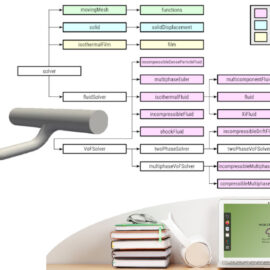
In Year 9 of CFD Direct, we built on the success modular solvers and non-conformal coupling in OpenFOAM. We replaced liquid film functionality and improved dynamic mesh, including mesh-to-mesh mapping, decomposition and redistribution, to the point that OpenFOAM can simulate internal combustion engines including piston and value motion. We managed the OpenFOAM Foundation, releasing OpenFOAM v11, packaging OpenFOAM-dev and publishing websites and documentation. We provided training and cloud services to OpenFOAM users, and began creating a new course “Productive CFD.”
IC Engines in OpenFOAM
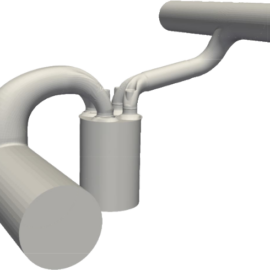
March 2024: CFD Direct is pleased to announce that OpenFOAM can simulate internal combustion (IC) engines including piston and valve motion. The capability was produced in collaboration with Wärtsilä, Finland and partner organisations, starting in October 2021. It is publicly available from The OpenFOAM Foundation in the development line of OpenFOAM (OpenFOAM-dev, packaged here), with example cases in the ICengines repository. Wärtsilä plan to release new features in the ICengines repository in August each year, following each new version release of OpenFOAM in July.
OpenFOAM v11 Training 2024

In Spring/Summer 2024, CFD Direct is running its OpenFOAM Training courses — Essential CFD, Applied CFD and Programming CFD — fully updated with the latest features of the new version 11 release of OpenFOAM. The training uses new features in OpenFOAM v11 for more productive and effective CFD. All courses are delivered as live virtual training. Essential and Applied CFD courses are available: 29 Jan-2 Feb, 4-8 Mar, 8-12 Apr, 13-17 May. Programming CFD is available 12-14 Feb, 18-20 Mar, 3-5 Jun, 24-26 Jun.
CFDDFC® v11 Released
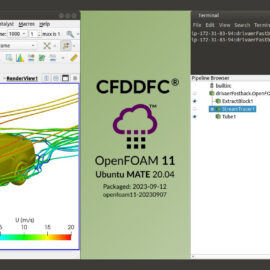
CFD Direct announces the release of version 11 of CFD Direct From the Cloud™ (CFDDFC®), available on Amazon Web Services (AWS) Marketplace as the standard CFDDFC product, Web CFDDFC and CFDDFC (Arm). Standard CFDDFC v11 includes OpenFOAM v11, ParaView v5.10, OpenMPI v4.1.5 and FreeCAD v0.20, running on Ubuntu 20.04 LTS. Web CFDDFC has the same software running on Ubuntu 22.04. CFDDFC (Arm) is server-only including OpenFOAM v11 and OpenMPI v4.1.5, running on Ubuntu 20.04 LTS. CFDDFC and Web CFDDFC run on single instances with up to 96 cores on Intel C7i instances (c7i.48xlarge) or C6a AMD instances (c6a.48xlarge) or in clusters with of instances up to 1000 cores or more.
Useful Tools in OpenFOAM 11

In 2016 we published a guide of Useful Tools in OpenFOAM with tools we first released in OpenFOAM v4. The tools included the post-processing CLI and template cases, and applications such as foamDictionary. We extended the article following the release of new tools such as TAB completion in OpenFOAM v5 and again later with the introduction of new tools in subsequent versions of OpenFOAM. This article describe more significant new tools introduced in OpenFOAM version 11, notably foamToC and foamPostProcess, to provide compatibility with its modular solvers, while maintaining backward-compatibility with application solvers.
OpenFOAM v11 Training

In Autumn 2023 – Spring 2024, CFD Direct is running its OpenFOAM Training courses — Essential CFD, Applied CFD and Programming CFD — fully updated with the latest features of the new version 11 release of OpenFOAM. The training uses new features in OpenFOAM v11 for more productive and effective CFD, including: modular solvers; the
snappyHexMeshConfig utility to simplify meshing; the foamToC utility to search OpenFOAM; updated post-processing functionality; and, enhancements to dictionary input syntax. Essential and Applied CFD courses are available: 18-22 Sep, 2-6 Oct, 29 Jan -2 Feb (2024), 4-8 Mar. Programming CFD is available 23-25 Oct, 14-16 Nov, 12-14 Feb, 18-20 Mar.
OpenFOAM User Guide
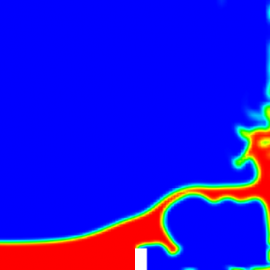
The OpenFOAM User Guide provides an introduction to OpenFOAM, through some basic tutorials, and some details about the general operation of OpenFOAM. OpenFOAM is a collection of approximately 250 applications built upon a collection of over 100 software libraries (modules). Each application performs a specific task, e.g the snappyHexMesh application can generate meshes for complex geometry, such as a vehicle. The simpleFoam application could then be used to simulate steady-state, turbulent, incompressible flow around the vehicle…
Liquid Films in OpenFOAM
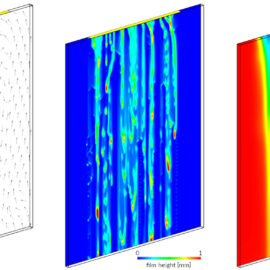
CFD Direct have completely replaced the liquid film functionality in OpenFOAM. The new film functionality conserves mass, unlike its predecessor which was non-conservative and consequently inaccurate and unreliable for many problems. It is implemented with the solver module framework, which enables coupling to other regions with gas flows, multiphase flows, particle clouds, solids etc, including calculations of conjugate heat transfer (CHT). As such, it is consistent with the rest of OpenFOAM so can use all the existing sub-modelling, e.g. thermodynamics, transport, etc. The new implementation contains 50% of the code lines of the original one, despite being more functional. It is therefore cheaper and easier to maintain, while being more extensible and robust.
CFD Direct Year 8: 2022-2023
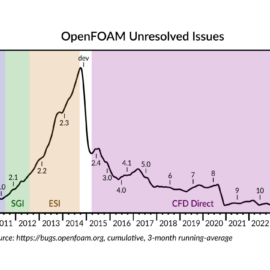
In Year 8 of CFD Direct, we made some very significant developments to OpenFOAM, including non-conformal coupling, modular solvers and redesign of the dynamic mesh functionality. We managed the OpenFOAM Foundation, releasing OpenFOAM v10, packaging OpenFOAM-dev and publishing websites and documentation. We provided 63 days of OpenFOAM Training to users around the world, supported by the release of our book, “Notes on Computational Fluid Dynamics: General Principles”. We released Web CFD Direct From the Cloud (CFDDFC®), providing OpenFOAM which can be accessed from a remote desktop running in a web browser.
Dynamic Meshes in OpenFOAM
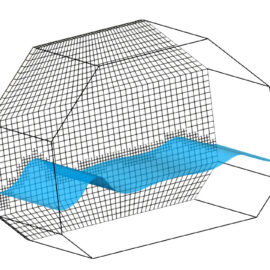
“Dynamic mesh” describes situations where the mesh in CFD changes, either topologically by adding or removing cells, or by capturing the motion of the solution domain. It also relates to changes in the distribution of cells during a parallel simulation. This article describes the redesign of dynamic mesh functionality, released in OpenFOAM v10 and the development version of OpenFOAM (OpenFOAM-dev). The redesign was motivated by the development of non-conformal coupling (NCC). It specifically overcame a limitation of the previous dynamic mesh functionality which permitted only a single form of mesh motion or topological change within a simulation.
Modular Solvers in OpenFOAM
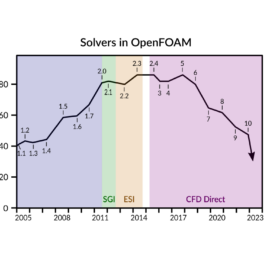
In August 2022, CFD Direct introduced modular solvers to the OpenFOAM development version. Modular solvers are written as classes, in contrast to the traditional application solvers which have been integral to OpenFOAM since icoFoam in 1993. They are simpler to use, maintain and understand than application solvers. They are more flexible; in particular, modules for different fluids and solids can be coupled across multiple regions, e.g. for conjugate heat transfer (CHT) with multiphase flow. Modular solvers are deployed using the foamRun or foamMultiRun applications, which contain a generic solution algorithm for single and multiple regions, respectively. Additional modules and applications replace existing tools for data processing and case configuration.
Web CFDDFC® Released
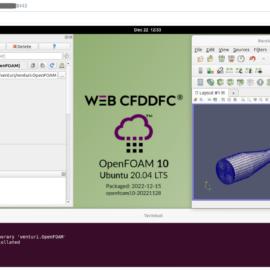
CFD Direct is pleased to announce the release of Web CFD Direct From the Cloud (CFDDFC®), providing OpenFOAM via a remote desktop in a web browser, running on Amazon Web Services (AWS). Web CFDDFC is a pay-as-you-go Amazon Machine Image (AMI) from AWS Marketplace, providing a full desktop environment with graphical applications, including OpenFOAM v10, ParaView v5.6.0, OpenMPI v4.1.1 and FreeCAD v0.19.2, running on Ubuntu 20.04 LTS. Web CFDDFC runs on single instances with up to 64 C6i Intel cores (c6i.32xlarge) or 96 C6a AMD cores (c6a.48xlarge), and in clusters with with good parallel scaling on clusters of instances up to 1000 cores.
Effective OpenFOAM Maintenance
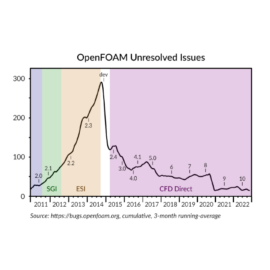
OpenFOAM is the leading free, open source software for computational fluid dynamics (CFD), distributed by The OpenFOAM Foundation. In 2014, OpenFOAM had accumulated significant “technical debt” due to a drive for new functionality at the expense of maintenance. Facing an unsustainable level of technical debt, CFD Direct was founded to manage and develop OpenFOAM back to a sustainable position. Code repair has targeted niche functionality that receives less testing. Redesign of larger, critical components of OpenFOAM has eliminated clusters of issues. By 2022, CFD Direct has recovered most of the technical debt, making OpenFOAM significantly more robust, usable and extensible.
OpenFOAM v10 Training 2023

In Spring/Summer 2023, CFD Direct is running its OpenFOAM Training courses — Essential CFD, Applied CFD and Programming CFD — fully updated with the latest features of the new version 10 release of OpenFOAM. The training uses new features in OpenFOAM v10 for more productive and effective CFD. All courses are delivered as live virtual training. Essential and Applied CFD courses are available: 6-10 Feb, 13-17 Mar, 24-28 Apr, 15-19 May. Programming CFD is available 24-36 Jan, 28 Feb-2 Mar, 28-30 Mar, 6-8 Jun, 26-28 Jun.
CFDDFC® v10 Released
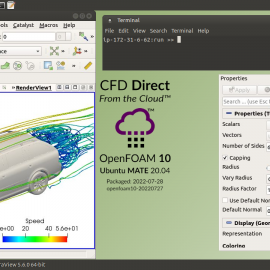
CFD Direct is pleased to announce the release of version 10 of CFD Direct From the Cloud™ (CFDDFC®), available on Amazon Web Services (AWS) Marketplace as the standard CFDDFC product and CFDDFC (Arm). Standard CFDDFC v10 includes OpenFOAM v10, ParaView v5.6.0, OpenMPI v4.1.1 and FreeCAD v0.19.2, running on Ubuntu 20.04 LTS. CFDDFC (Arm) is server-only including OpenFOAM v10 and OpenMPI v4.1.1, running on Ubuntu 20.04 LTS. CFDDFC runs on single instances with up to 64 C6i Intel cores (c6i.32xlarge), 96 C6a AMD cores (c6a.48xlarge) or 64 C7g Graviton cores (c7g.16xlarge) and in clusters with with good parallel scaling on clusters of instances up to 1000 cores.
OpenFOAM v10 Training

In Autumn 2022 – Spring 2023, CFD Direct is running its OpenFOAM Training courses — Essential CFD, Applied CFD and Programming CFD — fully updated with the latest features of the new version 10 release of OpenFOAM. The training uses new features in OpenFOAM v10 for more productive and effective CFD. All courses are delivered as live virtual training. Essential and Applied CFD courses are available: 19 – 23 Sep, 3-7 Oct, 6-10 Feb (2023), 13-17 Mar. Programming CFD is available 17-19 Oct, 1-3 Nov, 24-26 Jan (2023), 28 Feb-2 Mar, 28-30 Mar.
OpenFOAM Non-Conformal Coupling
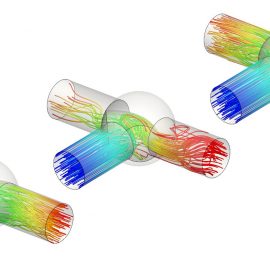
In May 2022, CFD Direct released Non-Conformal Coupling (NCC) in OpenFOAM to connect regions of a domain with independent meshes for applications including rotating geometry. NCC is a robust replacement for the Arbitrary Mesh Interface (AMI) and associated ACMI and Repeat AMI functionalities. Unlike the AMI functionalities, NCC ensures conservation which is essential for accuracy but also for stability, in particular in numerical schemes designed to maintain boundedness, e.g. in multiphase flows. NCC naturally works for partially-overlapping geometries, as illustrated by the case of opening and closing of a three port ball value.
Using NCC in OpenFOAM
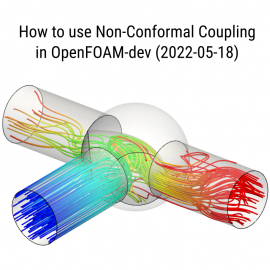
In May 2022, CFD Direct released Non-Conformal Coupling (NCC) in OpenFOAM to connect regions of a domain with independent meshes for applications including rotating geometry. NCC is a robust replacement for the Arbitrary Mesh Interface (AMI) and associated ACMI and Repeat AMI functionalities. This document describes how to use NCC to enable OpenFOAM users to transition from the AMI functionality to NCC. Due to its popularity, AMI remains in OpenFOAM for the next version 10 release in July 2022, but will thereafter be removed. The unreliable ACMI and Repeat AMI functionalities are removed.
CFD Direct Year 7: 2021-2022
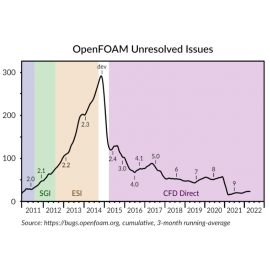
In Year 7 of CFD Direct, our developments of OpenFOAM included a generalised load balancer for parallel running . We provided core maintenance, including standardisation of fluid properties, and repaired issues, e.g. to stablise multiphase simulations. We managed the OpenFOAM Foundation, releasing OpenFOAM v9, packaging OpenFOAM-dev and publishing websites and documentation. We produced our book , “Notes on Computational Fluid Dynamics: General Principles”, delivered 56 days of Live Virtual OpenFOAM Training, and provided cloud CFD with CFDDFC® to over 1000 subscribers.
CFD Book for OpenFOAM
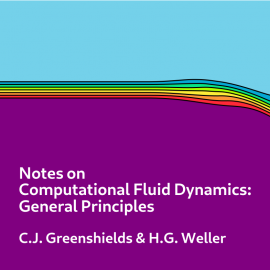
CFD Direct is delighted to announce its publication of a book Notes on Computational Fluid Dynamics: General Principles. The book is written for people who use CFD in their work, research or study, providing essential knowledge to perform CFD analysis with confidence. It offers a modern perspective on CFD with the finite volume method, as implemented in OpenFOAM and other popular general-purpose CFD software. Fluid dynamics, turbulence (and RAS modelling) and boundary conditions are presented alongside the numerical methods and algorithms in a series of short, digestible notes.
OpenFOAM v9 Training 2022

In Spring/Summer 2022, CFD Direct is running its OpenFOAM Training courses — Essential CFD, Applied CFD and Programming CFD — fully updated with the latest features of the new version 9 release of OpenFOAM. The training uses new features in OpenFOAM v9 for more productive and effective CFD. All courses are delivered as live virtual training. Essential and Applied CFD courses are available: 7-11 Feb, 14-18 Mar, 9-13 May, 6-10 Jun. Programming CFD is available 25-27 Jan, 22-24 Feb, 29-31 Mar, 23-25 May, 21-23 Jun.
CFDDFC on AWS C6i/M6i
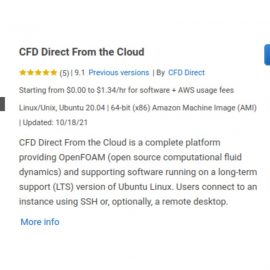
CFD Direct From the Cloud (CFDDFC®) is our established platform for running OpenFOAM, ParaView and supporting software using cloud computing. CFDDFC is now available on AWS C6i and M6i instances of Elastic Cloud Compute (EC2). These instances use the 32-core 2.9 GHz (3.5 GHz with turbo-boost) Intel Xeon Platinum 8375C (Ice Lake) processor. With 2 processors per socket, the largest single instances, c6i.32xlarge and m6i.32xlarge, includes 64 cores. C6i and M6i instances run at up to 50 Gbps of network speed at the largest instance size, which also supports Elastic Fabric Adapter to provide high speed networking across a cluster of instances.
CFDDFC® v9 Released
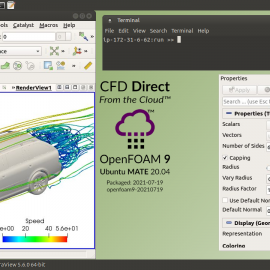
CFD Direct is pleased to announce the release of version 9 of CFD Direct From the Cloud™ (CFDDFC®), available on Amazon Web Services (AWS) Marketplace as the standard CFDDFC product and CFDDFC (Arm). Standard CFDDFC v9 includes OpenFOAM v9, ParaView v5.6.0, OpenMPI v4.1.1 and FreeCAD v0.19.2, running on Ubuntu 20.04 LTS. CFDDFC (Arm) is server-only including OpenFOAM v9 and OpenMPI v4.1.1, running on Ubuntu 20.04 LTS. CFDDFC runs on single instances with up to 48 C5 Intel cores (c5.24xlarge) or 64 C6 Arm-based cores (c6g.16xlarge) and in clusters with with good parallel scaling on clusters of instances up to 1000 cores.
OpenFOAM v9 Training

In Autumn 2021 – Winter/Spring 2022, CFD Direct is running its OpenFOAM Training courses — Essential CFD, Applied CFD and Programming CFD — fully updated with the latest features of the new version 9 release of OpenFOAM. The training uses new features in OpenFOAM v9 for more productive and effective CFD. All courses are delivered as live virtual training. Essential and Applied CFD courses are available: 20 – 24 Sep, 18-22 Oct, 7-11 Feb (2022), 14-18 Mar. Programming CFD is available 28-30 Sep, 2-4 Nov, 23-25 Nov, 25-27 Jan (2022), 22-24 Feb, 29-31 Mar.
OpenFOAM Models & Constraints
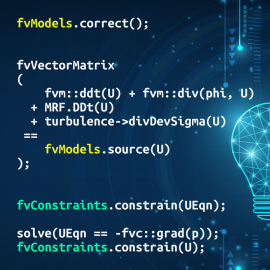
In March 2021, CFD Direct replaced fvOptions with new fvModels and fvConstraints classes. fvModels provided a more complete framework for implementation of complex models which could be optionally selected during a simulation. New fvModels were implemented for heat transfer and sources, which are easier to configure than a general fvOption. Pressure limiting was implemented as an fvConstraint named limitPressure, consistent with limitVelocity and limitTemperature. With additional fvModels such as cloud and surfaceFilm, solvers such as reactingFoam replicate the functionality of several existing solvers which are deprecated.
Useful Tools in OpenFOAM

We design our OpenFOAM Training so that users can learn effective CFD, giving them the confidence to carry out CFD analysis, repeatedly, to a defined standard in a timely manner. We provide 4 courses that teach reliable procedures to configure, run and maintain CFD simulations. While creating and improving these courses, we have contributed useful tools to OpenFOAM for more productive CFD, so that users waste less time on routine tasks. They include the post-processing command line interface, template cases, and tools for case setup, monitoring simulations, quick documentation and code customisation.
CFD Direct Year 6: 2020-2021
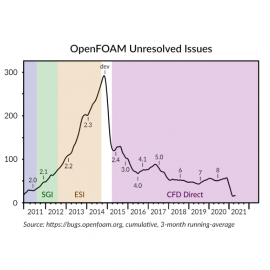
In Year 6 of CFD Direct, our developments of OpenFOAM included new interface capturing methods and multicomponent transport models. We provided core maintenance, including redesign of fvOptions and transport modelling, and repaired issues, e.g. in meshing and conjugate heat transfer. We managed the OpenFOAM Foundation, releasing OpenFOAM v8, packaging OpenFOAM-dev and publishing websites and documentation. During the Covid restrictions, we delivered 67 days of Live Virtual OpenFOAM Training, and provided cloud CFD with CFDDFC® to over 700 subscribers.
AWS HPC Competency 2021
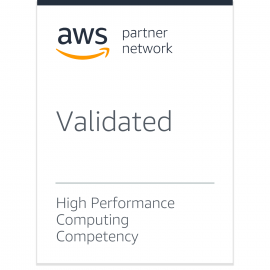
CFD Direct Limited has become one of the first approved Amazon Web Services (AWS) Partners to achieve High Performance Computing (HPC) Competency status. This designation recognises that CFD Direct has demonstrated deep experience helping customers optimise their computational fluid dynamics (CFD) workloads on AWS. Using CFD Direct From the Cloud™ (CFDDFC®), engineers and scientists can launch instances, pre-configured with OpenFOAM, in minutes — with up to 48 processors and clusters of 100s of processors.
Remote CFD with OpenFOAM

With restricted access to the workplace, a CFD engineer can be productive by quickly switching to remote CFD using CFD Direct From the Cloud™ (CFDDFC®) and by learning effective CFD. CFDDFC is a turnkey system with OpenFOAM and supporting software running in its native Linux environment on AWS. Engineers can launch remote instances (virtual machines) in 2 minutes providing remote desktop access to 96 core instances and scalable clusters of 100s of cores. At the same time the engineer can learn to be more productive by registering for our Live Virtual OpenFOAM Training, taken from the safety and comfort of their home using the CFDDFC system.
OpenFOAM v8 Training 2021

In Spring/Summer 2021, CFD Direct is running its OpenFOAM Training courses — Essential CFD, Applied CFD and Programming CFD — fully updated with the latest features of the new version 8 release of OpenFOAM. The training uses new features in OpenFOAM v8 for more productive and effective CFD. All courses are delivered as live virtual training due to Covid-19 travel restrictions in 2021. Essential and Applied CFD courses are available: 1-5 Feb, 15-19 Mar, 26-30 Apr. Programming CFD is available 26-28 Jan, 23-25 Feb, 23-25 Mar, 18-20 May.
Redesigning OpenFOAM for the Future
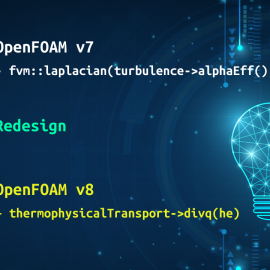
In 2020, CFD Direct were tasked to develop multicomponent diffusion modelling in OpenFOAM with funding from the Process Engineering Consortium. The Consortium need models, e.g. Maxwell-Stefan, that represent complex diffusion of species in fluid mixtures, affecting both specie concentration and energy. As part of the work, we created a new ThermophysicalTransportModels library with a new interfaces for: fluxes of heat, q() and divq(); and fluxes of mass, j() and divj(). As a consequence, heat transfer became consistent across applications, boundary conditions and data processing. This critical code redesign is typical of our strategy for sustainable development of OpenFOAM, supported by dedicated maintenance funding from OpenFOAM supporters.
CFDDFC® v8 for Azure
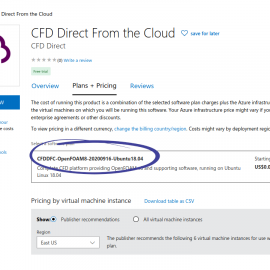
CFD Direct is pleased to announce the release of version 8 of CFD Direct From the Cloud™ (CFDDFC®) for Microsoft Azure. Available from the Azure Marketplace, CFDDFC v8 includes OpenFOAM v8, ParaView v5.6.0, OpenMPI v2.1.1 and FreeCAD v0.18.3, running on Ubuntu 18.04 LTS. Users can launch pay-as-you-go VMs from the image in minutes and connect via remote desktop or terminal login using SSH. Azure offers a wide range of VM types including the compute-optimised F-series with up to 36 physical cores (F72sv2) and the high performance computing H-series.
CFDDFC (Arm) for AWS C6g
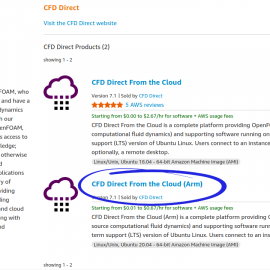
CFD Direct has launched CFDDFC® (Arm), a marketplace product on Amazon Web Services (AWS) for computational fluid dynamics (CFD) with OpenFOAM. CFDDFC (Arm) is a variant of CFD Direct From the Cloud™ for Amazon EC2 instances running Arm-based Graviton2 processors, in particular the C6g instances for compute-intensive workloads. CFDDFC (Arm) operates in server-mode without graphical applications and includes OpenFOAM 7 and OpenMPI 4.0.3 running on Ubuntu Server for Arm 20.04 LTS. For batch CFD jobs with guaranteed access on-demand, users can save 35% on their EC2 costs with C6g instances.
CFDDFC® v8 Released
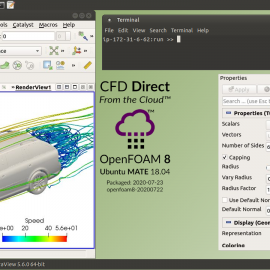
CFD Direct is pleased to announce the release of version 8 of CFD Direct From the Cloud™ (CFDDFC®), available on Amazon Web Services (AWS) Marketplace as the standard CFDDFC product and CFDDFC (Arm). Standard CFDDFC v8 includes OpenFOAM v8, ParaView v5.6.0, OpenMPI v3.1.4 and FreeCAD v0.18.3, running on Ubuntu 18.04 LTS. CFDDFC (Arm) is server-only including OpenFOAM v8 and OpenMPI v4.0.3, running on Ubuntu 18.04 LTS. CFDDFC runs on single instances with up to 48 C5 Intel cores (c5.24xlarge) or 64 C6 Arm-based cores (c6g.16xlarge) and in clusters with with good parallel scaling on clusters of instances up to 1000 cores.
Interface Capturing in OpenFOAM
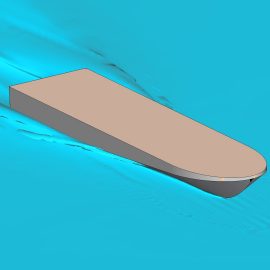
In July 2020, CFD Direct released a framework for surface interpolation in interface capturing for multiphase flows in OpenFOAM. All interpolation schemes, used for flux calculation in advection, operate with the MULES-based solvers, e.g. interFoam. The framework is easy to use, extensible, and robust due to bounded, conservative numerics. The new framework comes with a new family of interpolation schemes based on piecewise-linear interface calculation (PLIC). The PLIC schemes provide a promising alternative to standard interface compression, performing better for meshes with regions of cell refinement. All schemes are conservative, bounded and robust and can run efficiently with large time steps.
CFD Direct Year 5: 2019-2020
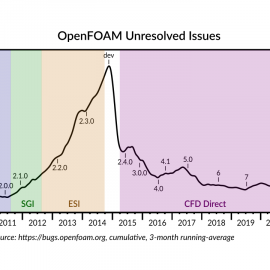
In Year 5 of CFD Direct, we developed new functionality in OpenFOAM and maintained critical components of the code base. We managed the OpenFOAM Foundation: promoting sustainable development, releasing OpenFOAM v7, packaging OpenFOAM-dev and publishing websites and documentation. We delivered 60 days of OpenFOAM Training, and provided low-cost cloud CFD with CFD Direct From the Cloud™ to over 500 subscribers, including custom images to run 100s of automated production simulations.
OpenFOAM Training & COVID-19

Many countries have imposed travel restrictions, limited gatherings and encouraged people to self-isolate and work from home due to the COVID-19 pandemic. CFD Direct is therefore re-scheduling some classroom OpenFOAM training as Virtual Training using a video conference between the instructor and participants. Participants work on CFD problems through a remote desktop to OpenFOAM running in the cloud. All machines are accessible to the instructor who can then assist with any problems. Virtual courses will run over a longer schedule and include an extra assistant to support participants during the training.
OpenFOAM v8 Training

In Autumn 2020 – Winter/Spring 2021, CFD Direct is running its OpenFOAM Training courses — Essential CFD, Applied CFD and Programming CFD — fully updated with the latest features of the new version 8 release of OpenFOAM. The training uses new features in OpenFOAM v8 for more productive and effective CFD. All courses are delivered as live virtual training due to Covid-19 travel restrictions in 2020 into 2021. Essential and Applied CFD courses are available: 28 Sep – 2 Oct, 19-23 Oct, 2-6 Nov and 1-5 Feb (2021). Programming CFD is available 22-24 Sep, 6-8 Oct and 26-28 Jan, 23-25 Feb (2021).
Maintaining a CFD Capability

Your organisation has an expert in CFD with OpenFOAM. They deliver critical results to problems no one else can solve. They have worked there as long as you can remember. Then one day they announce they are leaving and years of experience and know-how walks out of the door. “That-person-left syndrome”, as we call it, is a failure in maintenance which CFD Direct can help with. We provide development, support, training and cloud services to limit the impact of that-person-left syndrome, building a sustainable CFD capability for our customers with OpenFOAM.
OpenFOAM HPC with AWS EFA
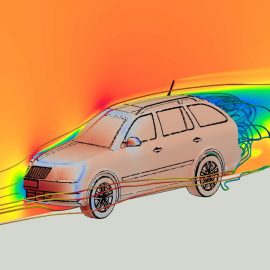
In November 2018, Amazon Web Services (AWS) announed Elastic Fabric Adapter, a network interface for HPC applications running on EC2. We previewed the EFA technology, running benchmark CFD simulations with OpenFOAM, presented previously: (1) strong scaling – 97 m total cells, external aerodynamics around a car; (2) weak scaling – 100 k cells per core, flow over a weir. At 1008 cores, EFA delivered linear scaling in the strong scaling test and ~70% scaling in the weak scaling test. With linear strong scaling, EFA enables faster solutions for the same cost simply by running on more cores. The combination of open source software, C5n instances and EFA provides impressive HPC, at a price accessible to all.
OpenFOAM HPC with AWS C5n
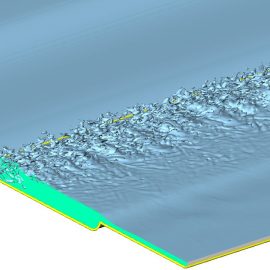
CFD Direct From the Cloud™ (CFDDFC) is a Marketplace Product for AWS EC2, that provides a complete platform with OpenFOAM and supporting software running on Ubuntu Linux. It enables simple, fast creation of a cluster of instances to run CFD with OpenFOAM. We tested Amazon EC2 C5n instances, launched in November 2018, on 2 cases of steady-state, external aerodynamics around a car and transient simulation of water flowing over a weir. With meshes of 50-100 million cells, results showed 70%-90% scaling at 504 cores. The cost of the simulations was in the order of $100, compared to $100,000+ to purchase on-premises hardware and licences of proprietary software.
CFDDFC v7.0 Released
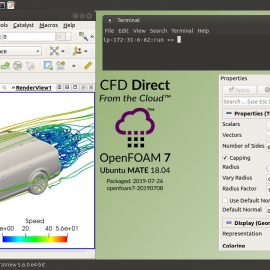
CFD Direct is pleased to announce the release of version 7.0 of CFD Direct From the Cloud™ (CFDDFC), the leading marketplace product for CFD on Amazon Web Services. CFDDFC v7.0 includes OpenFOAM v7, ParaView v5.6.0, OpenMPI v3.1.4 and FreeCAD v0.18.3, running on Ubuntu 18.04 LTS. CFDDFC v7.0 supports Elastic Network Adapter and Elastic Fabric Adapter which provide higher network performance on C5n instances. This delivers good parallel scaling performance on clusters of instances up to 1000 cores. The command line interface includes new options from simple launch of clusters and monitoring of costs.
CFD Direct Year 4: 2018-2019
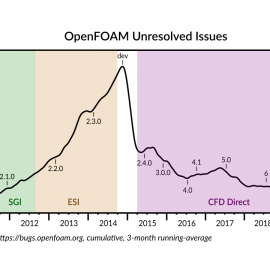
In Year 4 of CFD Direct, we developed new functionality in OpenFOAM and maintained critical components of the code base, reducing the number of unresolved issues by 17%. We managed the OpenFOAM Foundation: promoting sustainable development, releasing OpenFOAM v6, packaging OpenFOAM-dev and publishing websites and documentation. We contributed 1383 man-hours of unfunded work in-kind to OpenFOAM, including organising and presenting at the OpenFOAM Open Day. We delivered 60 days of OpenFOAM Training, and provided low-cost cloud CFD with CFD Direct From the Cloud™, running 1.3 million core-hrs.
OpenFOAM v7 Training 2020

In Spring 2020, CFD Direct is running its OpenFOAM Training courses — Essential CFD, Applied CFD, and Programming CFD — fully updated with the latest features of the new version 7 release of OpenFOAM. Essential and Applied CFD courses are available — with some remote places for remote attendance — on: 3-6 Feb, London UK; 24-27 Feb, Houston USA; 11-15 May, Virtual; 15-19 Jun, Virtual. Programming CFD is available as Virtual Training on 28-30 Jan, 17-19 Mar, 9-11 and 7-9 Jul.
OpenFOAM Sustainability 2018

OpenFOAM sustainability involves developing software that meets critical needs of users, through a balance of resources, technology, investment and institutional support. The critical needs are availability, usability, robustness and extensibility. The critical work required to meet those needs are publishing, repair and redesign. Employers rarely allocate time to individuals to contribute critical work, so it is generally left to “career maintainers” at CFD Direct. With limited funding, decisions about the critical work are made by those who fund and/or contribute the work, via The OpenFOAM Hub.
CFDDFC on AWS C5/M5
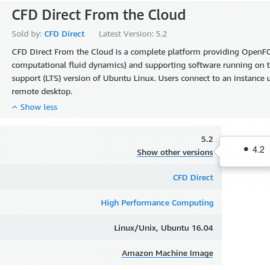
CFD Direct From the Cloud (CFDDFC) is our established platform for running OpenFOAM, ParaView and supporting software using cloud computing. CFDDFC is now available on AWS C5 and M5 instances of Elastic Cloud Compute (EC2). The CFDDFC product page on AWS MarketPlace now lists CFDDFC versions 5.2 and 4.2, corresponding to versions 5 and 4 of OpenFOAM, respectively. Users who launch CFDDFC with the command line interface should update their installation of CFDDFC immediately.
CFD Direct Year 3: 2017-2018
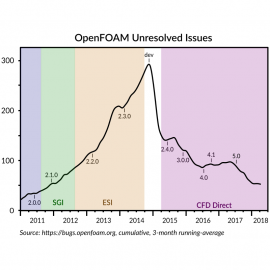
In Year 3 of CFD Direct, we developed new functionality in OpenFOAM and maintained critical components of the code base, reducing the number of unresolved issues by 45%. We managed the OpenFOAM Foundation: promoting sustainable development, releasing OpenFOAM v5, packaging OpenFOAM-dev and publishing websites and documentation. We delivered 60 days of OpenFOAM Training, introducing our new “hybrid” classroom-virtual courses to host participants in person and remotely. We launched the new Cloud CFD course to teach inexpensive, secure, efficient CFD with CFD Direct From the Cloud™.
OpenFOAM v7 Training
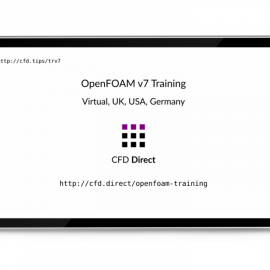
In Autumn 2019, CFD Direct is running its OpenFOAM Training courses — Essential CFD, Applied CFD, Programming CFD and Cloud CFD — fully updated with the latest features of the new version 7 release of OpenFOAM. Essential and Applied CFD courses are available: 24-27 Sep, London UK; 15-18 Oct, Chicago USA; 30 Oct – 1 Nov and 5-7 Nov, Virtual Training; 12-15 Nov, Munich Germany. Programming CFD is available 11-13 Sep and 2-4 Oct as Virtual Training. We use new features in OpenFOAM v7 for more productive and effective CFD.
OpenFOAM v6 Training 2019

In Spring 2019, CFD Direct is running its OpenFOAM Training courses — Essential CFD, Applied CFD, Programming CFD and Cloud CFD — fully updated with the latest features of the new version 6 release of OpenFOAM. Essential and Applied CFD courses are available — with some remote places for remote attendance — on: 4-7 Feb, London UK; 25-28 Feb, Houston USA; 20-23 May, Cologne Germany; 13-16 Jun, Denver USA. Programming CFD is available 29-31 Jan and 12-14 Mar as Virtual Training.
OpenFOAM v6 Training
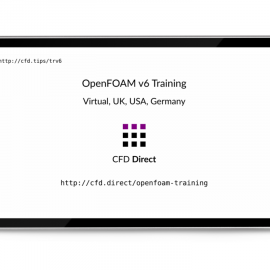
In Autumn 2018, CFD Direct is running its OpenFOAM Training courses — Essential CFD, Applied CFD, Programming CFD and Cloud CFD — fully updated with the latest features of the new version 6 release of OpenFOAM. Essential and Applied CFD courses are available: 24-27 Sep, London UK; 15-18 Oct, Chicago USA; 30 Oct – 1 Nov and 5-7 Nov, Virtual Training; 12-15 Nov, Munich Germany. Programming CFD is available 11-13 Sep and 2-4 Oct as Virtual Training. We use new features in OpenFOAM v6 for more productive and effective CFD.
Cloud CFD Course | OpenFOAM
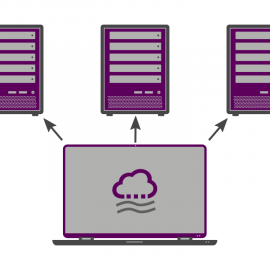
CFD Direct announces the release of their new 1 day Cloud CFD course, the fourth course in their portfolio of OpenFOAM Training. The course enables users to run CFD with OpenFOAM on AWS, training the tools and processes for inexpensive, secure, efficient cloud use. The course addresses the main concerns of using public cloud: cost management, security, efficient CFD and data management. It exploits the cost benefits of cloud: meeting fluctuating demand for hardware at a cost that represents consistent, high utilitisation; and using cheaper, spare capacity, with an application that does not require 100% availability.
Sustainable OpenFOAM Development

OpenFOAM is free, open source software for computational fluid dynamics (CFD). At the heart of OpenFOAM is a development kit (“SDK”), providing software and tools to build CFD applications, enabling users to customise their CFD, quickly and conveniently. CFD Direct includes OpenFOAM developers who maintain the SDK. We manage an environment for sustainable OpenFOAM development that involves: early public code release with rapid-turnaround user feedback; a network of developers, funding companies and users; and, co-ordinated code integration and maintenance.
OpenFOAM v5 Training
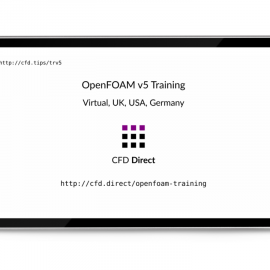
In Autumn 2017, CFD Direct are running their OpenFOAM Training courses — Essential CFD, Applied CFD and Programming CFD — fully updated with the latest features of the new version 5 release of OpenFOAM. Essential and Applied CFD courses are available: 25-28 Sep, London UK, and 16-19 Oct, Chicago USA with limited places via the Internet; 6-9 November, Munich Germany. Programming CFD is available 12-13 Sep and 3-4 Oct as Virtual Training. We use new features in OpenFOAM v5 to give our participants the confidence to carry out CFD analysis, repeatedly, to a defined standard in a timely manner.
CFDDFC Command Line Interface
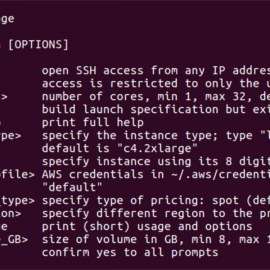
CFD Direct From the Cloud (CFDDFC) is our established platform for running OpenFOAM, ParaView and supporting software using cloud computing. We are pleased to announce the release of our CFDDFC command line interface (CLI) for quick, simple, deployment of OpenFOAM CFD workloads with CFDDFC on Amazon EC2. The CLI is a simple shell script named “cfddfc” that users can follow a few short short steps to get running. It uses EC2 Spot Instances by default, and provides cost estimates for data transfer to help users run workloads at lowest cost.
Water Waves in OpenFOAM
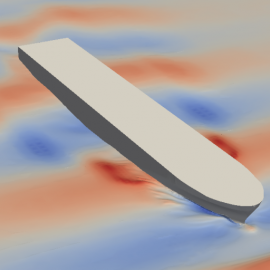
In May 2017, we implemented water wave modelling into the public, development line of OpenFOAM (OpenFOAM-dev), to simulate flow conditions experienced in marine and offshore engineering, e.g. on a ship in open water. The initial implementation includes the first order Airy wave and the second order Stokes wave (Stokes II), a second-order accurate utility to apply waves for case initialisation to the entire domain. A verticalDamping source (fvOption) provides wave damping towards outlet regions and an interfaceHeight function object processes interface elevation at specified locations.
OpenFOAM Barycentric Tracking
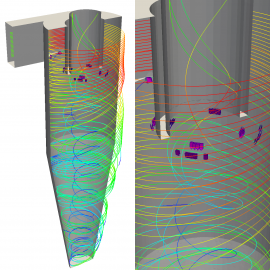
In April 2017, we added barycentric tracking into the public, development line of OpenFOAM (OpenFOAM-dev), as a complete replacement to the tracking algorithm that existed in OpenFOAM for over 10 years. Barycentric tracking works on any decomposed tet mesh, irrespective of mesh quality, including poor quality, flat and inverted tetrahedra. The new development was funded from the €100 k for OpenFOAM maintenance, raised through the OpenFOAM Foundation in 2017, in which “particles and tracking” was identified as an area in OpenFOAM “requiring significant code refactoring and/or rewriting”.
CFD Direct Year 2: 2016-2017
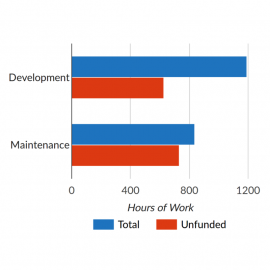
At the end of Year 2 of CFD Direct, we summarise our principal activities as the primary contributor to OpenFOAM. We developed new functionality, producing OpenFOAM v4.0 and v4.1, maintaining the OpenFOAM code base, documentation, websites and other infrastructure — where we contributed 1300 man-hours of work in-kind. We delivered 55 days of OpenFOAM Training — Essential, Applied and Programming CFD — as scheduled classroom courses, live virtual training and on-site. We released new versions of our cloud CFD platform, CFD Direct From the Cloud (CFDDFC), and became and Advanced Technology Partner of Amazon Web Services.
CFD Direct Year 2: Development

During Year 2, CFD Direct made over 1000 code commits to the public development line of OpenFOAM, making us by far the largest contributor of code to OpenFOAM. We produced the major new version 4.0 release of OpenFOAM and the minor update version 4.1 release. We transformed OpenFOAM-dev into stable software of “always-releasable” quality and package it weekly for Ubuntu. Ubuntu packs can now be installed directly on Windows 10 and we also provide “containerized” versions, hosted on Docker Hub, accompanied by launch scripts for easy installation of OpenFOAM on Linux and macOS.
CFD Direct Year 2: Maintenance
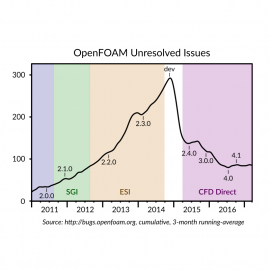
In Year 2, CFD Direct handled almost 500 issues on the OpenFOAM issue tracking system. We upgraded the system and and analyzed metrics relating to timely resolution of issues which concluded that current unresolved issues relate to badly designed components of OpenFOAM that require significant code rewriting. To fund that repair work and ongoing maintenance, we ran a successful campaign to raise €100 k from companies that benefit from OpenFOAM. We carried out substantial maintenance to OpenFOAM websites, significant updates to documentation, and administration for the OpenFOAM Foundation.
CFD Direct Year 2: Training

In Year 2, CFD Direct delivered 55 days of OpenFOAM Training with its 3 × 2 day courses, Essential CFD, Applied CFD and Programming CFD. Training was delivered as: scheduled Classroom Training in London, Berlin, Munich, Houston, Chicago and Beijing; live Virtual Training; and, customer On-Site Training. We launched our Programming CFD course, containing modules in C++ programming applied to popular examples in OpenFOAM. We successfully ran live Virtual Training courses with participants from a wide geographical area. And we updated Training for OpenFOAM v4, that included our changes to make OpenFOAM easier to use.
CFD Direct Year 2: Cloud
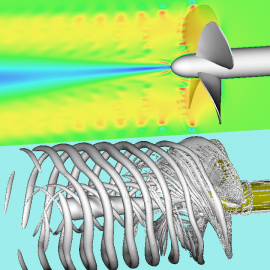
In Year 2, CFD Direct updated its OpenFOAM cloud computing platform — CFD Direct From the Cloud (CFDDFC) — to OpenFOAM 4.1, running on Ubuntu 16.04. Feedback from users was very positive, including a 5-star rating on the CFDDFC Marketplace Product page at at Amazon Web Services (AWS). We became an Advanced Technology Partner of AWS, and produced a case study on the cost of CFD on AWS EC2 that concluded, in particular, that the cost of Spot instances was approximately 40% of the total cost of ownership of on-premises hardware. We made CFDDFC available on AWS X1 instance types, running simulations on 32 and 64 physical cores in a single instance.
OpenFOAM Maintenance

OpenFOAM is free, open source software in computational fluid dynamics for real-world engineering and scientific applications. CFD Direct is committed to maintain OpenFOAM, demonstrated by the thousands of code commits to OpenFOAM-dev, with support from contributors. Maintenance concerns the evolution of software in response to changes in user expectation and environment. We have introduced an agile strategy suitable to the feedback process of software evolution and have identified key areas of OpenFOAM that requiring significant redesign, e.g. AMI and particles.
Cost of CFD in the Cloud
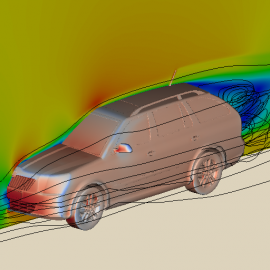
Cloud computing replaces large upfront expenses with low, variable payments that only apply to what you use. CFD simulations cover a range of sizes and complexity. Activity is generally interrupted by quiet periods when simulations are halted, e.g. when a simulation ends non-working hours, during analysis of results or preparation of a new simulation, etc. The fluctuating demand makes CFD well suited to a pay-per-use model. Users need to understand the costs involved to get the best value from cloud and be confident that they fall within budget. This article explains the costs, with an example of an external aerodynamics calculation with OpenFOAM using CFD Direct From the Cloud™ (CFDDFC) on Amazon Web Services (AWS).
Issues with OpenFOAM, Pt. 3
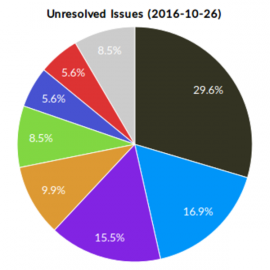
A breakdown of outstanding issues in OpenFOAM (2016-10-26) shows 90% of unresolved issues falling within only 7 categories. The two worst offenders account for almost half of all unresolved issues: 1) AMI, ACMI and cyclic interfaces; and, 2) heat transfer, including conjugate heat transfer (CHT). These categories, and “particles and tracking” and “sources/constraints” in particular, require significant refactoring and/or rewriting. Their current state of disrepair was caused by poor funding under a roadmap development strategy. Funding of agile development of OpenFOAM is now needed to support our aim to improve quality, with a target 50% reduction in unresolved issues in 2017.
Issues with OpenFOAM, Pt. 2
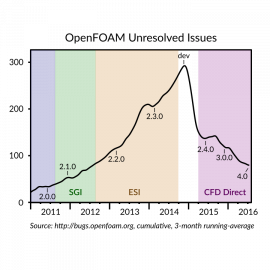
Agile development of OpenFOAM emerged following the public distribution of the development line in December 2014. It relies on user participation, which is encouraged by rewarding users for reporting issues with timely resolution. OpenFOAM was in poor health at version 2.3.0, with unresolved issues increasing rapidly and long resolution times. Following the move to agile development, unresolved issues are reduced and under control, with ~70% of issues resolved in 1 day and ~90% resolved in 1 week, taking OpenFOAM to a new level of quality and maturity (always releasable) by version 4.0.
Issues with OpenFOAM, Pt. 1

The OpenFOAM Issue Tracking system exists to enable users to report issues. An issue exists when OpenFOAM behaves in a manner that does not meet reasonable expectations, including in design and usability. OpenFOAM is mature, quality software, whose successful development demands that issues are resolved in a timely manner. Roadmap development obstructs issue resolution, resulting in unreliable software and inefficient development. Instead, free, open source software can exploit agile development with frequent code release, as the best strategy for CFD development. Users should adopt continuous upgrade to minimize cost and to benefit the agile development strategy.
Computational Fluid Dynamics
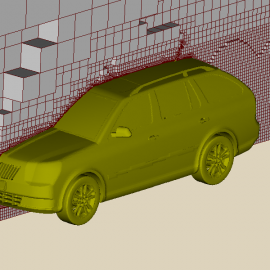
Fluid dynamics is concerned with the motion of fluids (liquids and gases) and the forces on them. “Computational” refers to computation of the flow and forces using numerical analysis. We define “computational fluid dynamics” as “the prediction of fluid motion and forces by computation using numerical analysis, generally extended to include heat, thermodynamics, chemistry and solids”. This definition covers a broad range of calculations for numerous scientific and engineering applications, in particular involving heat.
Energy Equation in OpenFOAM
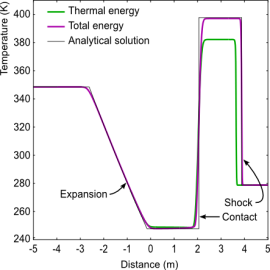
This article provides information on the equation describing conservation of energy relevant to fluid dynamics and computational fluid dynamics (CFD). It first assembles an equation for combined mechanical and thermal energy, i.e. total energy, in terms of material derivatives. It then presents an equation for thermal, or internal, energy. The total energy equation is then provided in terms of local (partial) derivatives, both in terms of internal energy and enthalpy. The implementation of the energy equation in solvers in OpenFOAM is then described.
Tensor Mathematics
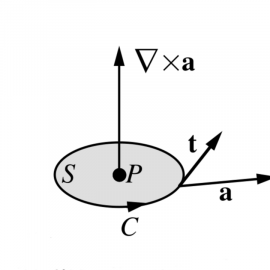
This article provides information on tensor mathematics, relevant to fluid dynamics and computational fluid dynamics (CFD). It describes scalars and vectors and typical algebraic vector operations. It follows with second rank tensors, their algebraic operations, symmetry, skewness and tensor invariants such as trace and determinant, higher rank tensors, co-ordinate system and change of axis. Tensor calculus is introduced (div, grad, curl and Laplacian), followed by integral theorems of Gauss and Stokes, with a physical representation of div and curl, and more.
OpenFOAM Linux Guide
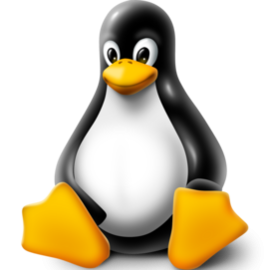
This guide provides information and example terminal commands for Linux, relevant to users of OpenFOAM. Commands are written that refer to OpenFOAM, e.g. they include OpenFOAM Linux environment variables. Those commands that refer to OpenFOAM will only function as stated, if they are executed on a machine on which OpenFOAM is installed and the user’s environment variables are set up for OpenFOAM, e.g. as described in the source download page (see Setting Environment Variables).
OpenFOAM v4 Training 2017
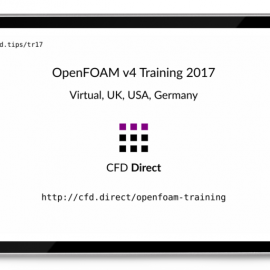
In 2017, CFD Direct are running sessions of their OpenFOAM Training courses — Essential CFD, Applied CFD and Programming CFD — fully updated with the latest features of the new version 4 release of OpenFOAM: 24-27 April 2017, Berlin Germany; 16-18 May, Virtual Asia-Pacific; 20-21 June, 26-27 June, Virtual Americas; 4-5 July, London UK; 12-13 Sept, Virtual Americas; 25-28 Sept, London UK; 16-19 October, Chicago USA. OpenFOAM v4 contains new functionality we introduced in OpenFOAM v4 to improve usability so our course participants spend less time struggling with quirks of the software, leaving more time to build and practice their CFD skills.
Inside OpenFOAM 4.0
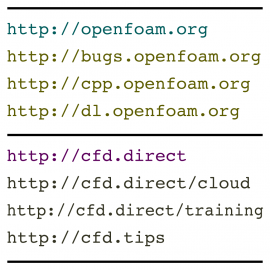
OpenFOAM version 4.0 is the latest major version of OpenFOAM, released on 28th June 2016. CFD Direct was by far the largest contributor to OpenFOAM 4.0, contributing the vast majority of new functionality including post-processing, numerous boundary conditions and physical models. Additionally, we contributed across all other aspects of software engineering that make OpenFOAM a mature, modern environment for CFD. This article provides the inside view of that work on the software engineering behind OpenFOAM 4.0, contributed largely during a 3 month period from April-July, 2016.
CFD Direct Year 1: 2015-2016

On 25th March 2015, CFD Direct was launched by Henry Weller (creator of OpenFOAM), Chris Greenshields, and Jenya Collings. At the end of our first year, we summarise our principal activities as the primary contributor to OpenFOAM, producing 3 releases of OpenFOAM, maintaining the OpenFOAM code base, managing the OpenFOAM Foundation, creating a free documentation resource and engaging with the community. We launched 3 training courses — Essential, Applied and Programming CFD — which we deliver as scheduled classroom courses, live virtual training and on-site. We launched CFD Direct From the Cloud (CFDDFC), a complete CFD cloud computing platform using Amazon Web Services EC2.
CFD Direct Year 1: OpenFOAM
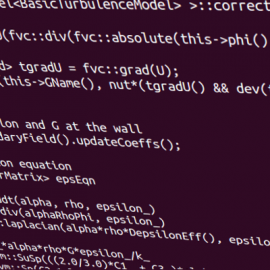
During our first year, we made over 900 code commits to the to the public development line of OpenFOAM, making us by far the largest contributor of code to OpenFOAM. In 2015, we produced one major, one minor and one patch release of OpenFOAM. We carried out maintenance on OpenFOAM, reducing the number of outstanding issues by approximately 35%, involving over 500 commits to the bug fix line of OpenFOAM 3.0. We managed the OpenFOAM Foundation, established a free OpenFOAM documentation resource, and our posts on social media updated users about developments to OpenFOAM , which encouraged a strong community to support and contribute to OpenFOAM as free software.
CFD Direct Year 1: Training

In April 2015, we launched 2 × 2 day courses, Essential CFD and Applied CFD, which were delivered as scheduled classroom training courses in Berlin, Houston, London, Chicago and Munich. In early 2016 we launched our 2 day course, Programming CFD, which we are delivering initially as Live Virtual Training. Our 3 OpenFOAM Training courses, aimed at competency in CFD, are now run as scheduled classroom courses, live virtual training and on-site training. We believe our comprehensive, modern programme is the best OpenFOAM training, using only free, open source software, for a one-time investment in staff skills without recurring licence fees.
CFD Direct Year 1: Cloud

In 2015, we launched CFD Direct From the Cloud (CFDDFC), a complete OpenFOAM cloud computing platform that includes the latest version of OpenFOAM and supporting software running on Ubuntu. The platform provides OpenFOAM in its native Linux OS, which users can access directly from a terminal or via a remote desktop. CFDDFC is available for Amazon Web Services (AWS) as a product on AWS Marketplace, pre-configured for Amazon Elastic Compute Cloud (EC2). CFDDFC is in constant use, on a range of EC2 Instances ranging from the small instance, eligible for Free Tier, to the Compute Optimized instances including the largest with 36 virtual (18 physical) CPUs, and with multiple instances networked as a cluster for larger workloads.
OpenFOAM is Free Software

OpenFOAM is free software, meaning users have the freedom to run, copy, distribute, study, change and improve the software. Users benefit from these freedoms, which account for much of OpenFOAM’s popularity. The OpenFOAM Foundation is the copyright holder of OpenFOAM, which it licenses exclusively under the GPL. It maintains a strong legal position to enforce the licence and preserve its freedoms, by being the single owner of OpenFOAM. This requires contributors to the project to assign copyright in their OpenFOAM contributions to it, through its Contributor Agreement. Organisations with a serious commitment to free software are signing the Agreement, including CFD Direct, blueCAPE, VTT Technical Research of Finland Ltd and Intel.
OpenFOAM Programming Course

CFD Direct announces the release of Programming CFD, their new OpenFOAM Training course. The OpenFOAM programming course has been created by Chris Greenshields (OpenFOAM co-founder) and Henry Weller (OpenFOAM creator/architect). The course is 2 days duration and is initially available as Virtual Training in Europe and Americas time zones, with Chris Greenshields as instructor: 12-13 April 2016 – Europe; 19-20 April 2016 – Americas. The course teaches coding to OpenFOAM’s quality standards with tools to encourage good practice, developing code in small, digestible steps with periods of reflection to introduce new concepts.
OpenFOAM v3.0 Training 2016

In January-March 2016, CFD Direct are running sessions of their OpenFOAM Training courses — Essential CFD and Applied CFD — fully updated with the latest features of the new version 3.0 release of OpenFOAM: 25-28 January 2016, London UK; 22-25 February 2016, Houston USA; 7-10 March 2016, Berlin Germany. OpenFOAM v3.0 contains new functionality we introduced in OpenFOAM v3.0 to improve usability so our course participants spend less time struggling with quirks of the software, leaving more time to build and practice their CFD skills.
Where is the Source Code?
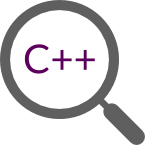
Where is the Source Code? is a campaign to promote free, public distribution of OpenFOAM and software that links intimately to OpenFOAM. It is in response to a general dissatisfaction with the practice of making a modification to OpenFOAM, then promoting the benefits of the modification, without making that modification freely available to the public, often in order to sell it commercially. The campaign is simply to get people to ask “Where is the Source Code?” when modifications like this are promoted, for example after a conference presentation or in a response to a discussion on the Internet.
OpenFOAM Training Pilot Sessions June 2015

CFD Direct are running 2 pilot sessions of their new OpenFOAM Training courses on: 1-4 June 2015, Berlin, Germany; 15-18 June 2015, Houston, TX USA. The 2×2 day courses, Essential CFD and Advanced CFD, have been developed to enable people to deliver successful CFD solutions with OpenFOAM. The new courses are a result of 6 months development, built on our experience as the Architects of OpenFOAM and of training 2500 people with OpenFOAM.
CFD Training with OpenFOAM
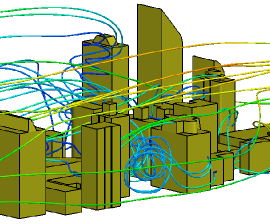
An earlier article described the OpenFOAM training through which Jenya Collings and I provided almost 500 days of instructor-led, classes to 2,500 particpants. That training mainly described the workings of the OpenFOAM for the early adopters of the software, but we need training whose focus is to enable people to deliver successful CFD solutions. CFD Direct have developed this training over several months, with a modular format that addresses all components of CFD and where the participant learns through experience on a wide range of real-world CFD examples. The training is built on developments to OpenFOAM that make it easier to use, such as template cases, packaged tools, reorganised input and re-coded features.
OpenFOAM Software Training

In 2008, the Directors of CFD Direct began the first significant OpenFOAM Training courses. The training was written for early adopters of OpenFOAM at a time when OpenFOAM was far less functional than today. The courses largely emphasised how OpenFOAM worked and a lot of time was devoted to code customisation. We pioneered a convenient method of providing participants with a running version of OpenFOAM using a persistent live installation that booted Linux from an 8GB USB pendrive. The wider user community benefited from our example cases, e.g. the motorbike case, and code changes made for the courses becoming part of OpenFOAM and our adoption of Ubuntu leading to the release of OpenFOAM packaged for Ubuntu.
Supporting CFD Analysis
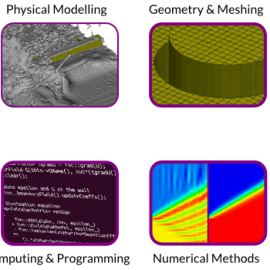
CFD analysis involves competency in fluid dynamics, physical modelling, meshing, numerical methods, data analysis, computing, programming. It is difficult to obtain knowledge and experience in these CFD competencies, even with broad access to information brought by today’s Internet. People are forced to rely heavily on colleagues or online forums because most CFD teaching is generally inadequate. At CFD Direct, it is our aim to support people to deliver timely, quality CFD analysis at a reasonable cost. Our belief in open source software means that the public are able to access information, such as numerical methods and physical models, through the source code of OpenFOAM. We supplement this by providing support and training services, and through our contributions to OpenFOAM, including free technical information.
